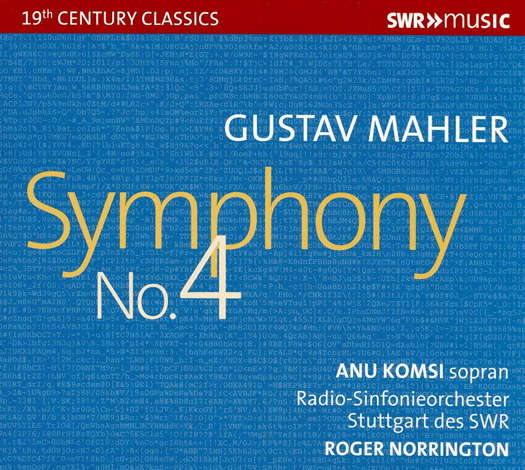 DISCUSSION: John Dante Prevedini leads a discussion about Composers, individuals or collective?, including contributions from David Arditti, Halida Dinova, Robert McCarney and Jane Stanley.
DISCUSSION: John Dante Prevedini leads a discussion about Composers, individuals or collective?, including contributions from David Arditti, Halida Dinova, Robert McCarney and Jane Stanley.

Why Mahler?
Roger Norrington's interpretation of
Mahler's Fourth Symphony,
heard by GERALD FENECH
'Roger Norrington presents the music very much as Mahler would have approved, and dynamics are never exaggerated. The orchestra is never allowed to be short on emotion and overall this performance is deeply moving. Anu Komsi is also perfectly cast as the child-like soprano in the last movement.'
In his biography of the composer, Norman Lebrecht asks the question, 'Why Mahler?' - which is in fact the name of the book - and then he comes up with the answer, 'How one man and ten symphonies changed the world'. Indeed, why Mahler? It's amazing, but more than a century after his death in 1911 aged nearly fifty, Gustav Mahler remains the most important composer of modern times, even in our 21st century.
His music inspires a unique devotion. Some even believe it can soothe emotional moods, and others are bowled over by the contradictory meanings that the music conveys. Whatever the case, Mahler's symphonies vividly capture the yearnings and anxieties of our troubled era. His anguished utterings have the power to transform human lives, and the way he expresses his tragic personal experiences, making you feel they are your own, is nothing short of miraculous. As a musician, Mahler was a renowned conductor; tyrannical and difficult, he immeasurably enhanced standards of performance and was partly responsible for revolutionising how operas are presented.
At this stage, apologies to all. Inadvertently, I have let myself get hooked by the Mahler syndrome, when the focus should be on the master's Fourth Symphony, a work that is rich in lyricism, melody and pastoral overtures, akin to Beethoven's Pastoral. So on with the motley.
The composition of this work dates from 1899-1900 and, like the preceding three symphonies, the themes originate from Mahler's own settings of folk poems from the collection Des Knaben Wunderhorn (The Boy's Magic Horn). Indeed, the fourth movement is built around a single song 'Das himmlische Leben' (The Heavenly Life), which Mahler had written some eight years earlier, in 1892. The song presents a child's vision of Heaven and is hinted at in all three previous movements.
Listen — Gustav Mahler: Sehr behaglich (Symphony No 4)
(track 4, 0:00-0:56) © 2005 SWR Media Services GmbH,
2019 Naxos Deutschland Musik & Video Vertriebs GmbH :
Mahler stressed the importance that the song be sung with serene child-like expression, completely without parody. Characteristics these, that permeate the whole score of this shortest symphony by the composer, but which all the same is written for a large orchestra, with an extensive percussion section that includes sleigh bells and a glockenspiel.
Listen — Gustav Mahler: Bedächtig, nicht eilen (Symphony No 4)
(track 1, 3:31-4:27) © 2005 SWR Media Services GmbH,
2019 Naxos Deutschland Musik & Video Vertriebs GmbH :
What is so fascinating is the fact that Mahler deploys his forces with a transparency and lightness of touch more in line with chamber music or a Mozart or Haydn. This reissue dates from 2005, but the technical quality is first class; indeed every nuance of Mahler's delightful score can be heard with ease.
Listen — Gustav Mahler: In gemächlicher Bewegung (Symphony No 4)
(track 2, 7:28-8:26) © 2005 SWR Media Services GmbH,
2019 Naxos Deutschland Musik & Video Vertriebs GmbH :
Roger Norrington presents the music very much as Mahler would have approved, and dynamics are never exaggerated. The orchestra is never allowed to be short on emotion and overall this performance is deeply moving. Anu Komsi is also perfectly cast as the child-like soprano in the last movement. A splendid Mahler 4th to savour and enjoy.
Copyright © 9 January 2020
Gerald Fenech,
Gzira, Malta

CD INFORMATION - GUSTAV MAHLER: SYMPHONY NO 4
FURTHER INFORMATION: GUSTAV MAHLER



